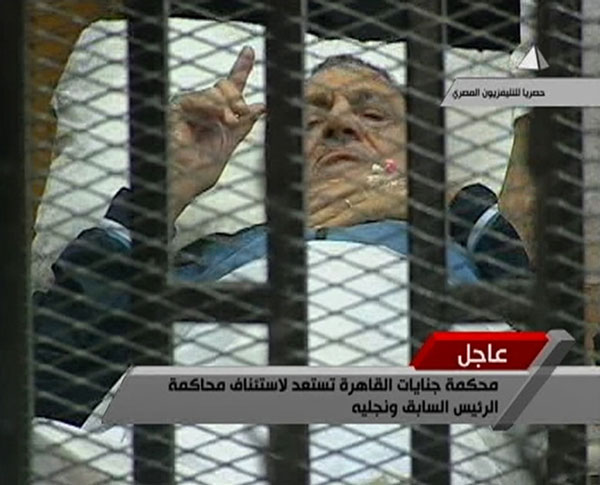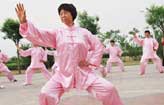Photos
Mubarak returns to court in Egypt
Updated: 2011-08-15 18:50
(Agencies)
|
 Former Egyptian President Hosni Mubarak gestures in the courtroom during his trial at the police academy in Cairo in this August 15, 2011 still image taken from video. [Photo/Agencies] |
A helicopter landed near the court and shortly afterwards the ailing Mubarak, aged 83 and wearing a navy blue sports sweater, was wheeled on a gurney into the courtroom's steel cage for the second session of his trial.
Hundreds of riot police stood guard but clashes erupted between a crowd of Mubarak supporters outside the building and a group demanding justice for those killed in the uprising that toppled him six months ago.
"The thief has arrived!" shouted the anti-Mubarak protesters, drawing whistles from his supporters.
"Judge wake up! Mubarak killed my brothers! Execute the killer!", shouted others.
The pro-Mubarak crowd threw stones, the police cordon dividing them broke and the Mubarak supporters chased their opponents away from the court building.
In a courtroom packed with excited lawyers, Mubarak looked composed and stern, hands clasped over his chest. An intravenous needle was implanted in his left hand. He was not wearing the regulation white clothes of prisoners.
He exchanged a few words with his sons Alaa and Gamal, also on trial and in the same cage with their father. They sought to shield him from cameras and one of them kissed Mubarak on the forehead to comfort him.
Judge Ahmed Refaat called Mubarak's name and he answered, "Present." Refaat appealed for calm, ordering them to sit down to allow proceedings to begin.
The hearing could decide if the head of the ruling military council will take the stand as a witness.
Defence lawyers say that any testimony by Field Marshal Mohamed Hussein Tantawi on Mubarak's role in trying to suppress the 18-day uprising, in which about 850 people were killed, could decide the ex-president's fate.
Tantawi, who was defence minister for two decades under Mubarak, heads the military council that took power when Mubarak was ousted on February 11 by the mass protests.
Tantawi's military council has promised a transition to democracy in the Arab world's most populous country -- a process far from complete and, the pro-reform camp says, vulnerable to high-level obstruction.
A Reuters reporter saw the crowds outside the court building form piles of stones to throw at each other. One protester attacked a policeman. Then police jumped on him and beat him.
"All this hatred is because we let an evil man rule us for 30 years," a senior police officer told Reuters without giving his name.
For generations, Arab world leaders ruled for life and were seldom held to account. But Mubarak now stands accused of authorising the use of live ammunition to quell protests, of corruption and abuse of power.
The charges against the former air force commander could carry the death penalty. He denied all accusations during the opening session, which was aired live and counted as his first public appearance since February 11.
Medical reports issued after Mubarak was taken to a hospital following initial questioning in April said he was suffering from heart problems, depression and fainting fits.
"I want people to read their history and know what this great man has done for us. He kept Egypt stable. He has been humiliated but he is weathering the storm with pride," said Ehab Sameh, 30, outside the court.
NOOSES
Mubarak's lawyer Farid al-Deeb demanded that the case be postponed to give him time to view all the documents submitted to court. Lawyers for the plaintiffs asked the judge to split the trial to consider separately the charges over killings from those surrounding graft in gas exports to Israel.
The judge ordered a recess to consider the requests.
Around 850 people were killed during the uprising and over 6,000 wounded when security forces fired live rounds, rubber bullets and used water cannon and batons against the protesters.
In the first court session, lawyers on both sides asked for Tantawi, former intelligence chief Omar Suleiman and about 1,600 others to testify as witnesses.
"Tantawi's testimony would help the court determine whether Mubarak gave orders to Interior Minister Habib al-Adli to fire at protesters or whether Adli was acting independently," said a member of the defence team, who asked not to be named.
A judge on Sunday set the next hearing for Adli and six of his lieutenants for September 5.
Lawyers for the families of those killed have also demanded that Tantawi testify.
Asked if Tantawi could appear as a witness, legal expert Mahmoud Khoudeiry said testimony from any army officer would be aired live unless there are specific security concerns.
"It is important for the court to meet the requests of the defence team, especially the request to hear the accounts of ... Tantawi in court to determine whether Mubarak asked him to confront and fire at protesters or not," the lawyer said.
"The defence team sees Tantawi as a compurgator, or a witness whose testimony would exonerate Mubarak. The plaintiffs' lawyers, however, expect him to testify that he received orders to fire, which is necessary to convict Mubarak," another lawyer handling the case said.
Essam Soltan, one of the plaintiffs' lawyers, said Refaat would ask lawyers to justify their request to summon Tantawi to testify before ruling on it.
The cases of the defendants are interlinked and each could accuse his superior of giving the orders to fire, thus weakening the case against Mubarak, Soltan said.
The military said officers called in by the judge to give their testimony would attend.
But a judicial source said that even if Tantawi were asked to testify, it would happen later in the trial to shield the army from taking the heat in the controversial case.
E-paper

Going with the flow
White-collar workers find a traditional exercise helps them with the frustrations of city life
The light touch
Long way to go
Outdoor success
Specials

Star journalist remembered
Friends, colleagues attended a memorial service to pay tribute to veteran reporter Li Xing in US.

Robots seen as employer-friendly
Robots are not new to industrial manufacturing. They have been in use since the 1960s.

A prosperous future
Wedding website hopes to lure chinese couples
